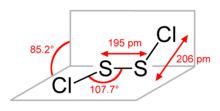


| |||
| |||
| Names | |||
|---|---|---|---|
| IUPAC name
Disulfur dichloride | |||
| Systematic IUPAC name
Dichlorodisulfane | |||
Other names
| |||
| Identifiers | |||
|
| |||
3D model (JSmol) |
|||
| ChemSpider |
| ||
| DrugBank | |||
| ECHA InfoCard | 100.030.021 | ||
| EC Number |
| ||
| MeSH | Sulfur+monochloride | ||
PubChem CID |
|||
| RTECS number |
| ||
| UNII | |||
| UN number | 3390 | ||
CompTox Dashboard (EPA) |
|||
| |||
| |||
| Properties | |||
| S2Cl2 | |||
| Molar mass | 135.02 g·mol−1 | ||
| Appearance | Light-amber to yellow-red, oily liquid[1] | ||
| Odor | pungent, nauseating, irritating[1] | ||
| Density | 1.688 g/cm3 | ||
| Melting point | −80 °C (−112 °F; 193 K) | ||
| Boiling point | 137.1 °C (278.8 °F; 410.2 K) | ||
| Decomposes, with loss of HCl | |||
| Solubility | Soluble in ethanol, benzene, ether, THF, chloroform, CCl4[2] | ||
| Vapor pressure | 7 mmHg (20 °C)[1] | ||
| −62.2·10−6cm3/mol | |||
Refractive index (nD) |
1.658 | ||
| Structure | |||
| C2 | |||
| 2 at sulfur atoms | |||
| gauche | |||
| 1.60 D[2] | |||
| Hazards | |||
| GHS labelling: | |||
   
| |||
| Danger | |||
| H301, H314, H332, H400 | |||
| P260, P261, P264, P270, P271, P273, P280, P301+P310, P301+P330+P331, P303+P361+P353, P304+P312, P304+P340, P305+P351+P338, P310, P312, P321, P330, P363, P391, P405, P501 | |||
| NFPA 704 (fire diamond) | |||
| Flash point | 118.5 °C (245.3 °F; 391.6 K) | ||
| 234 °C (453 °F; 507 K) | |||
| Lethal dose or concentration (LD, LC): | |||
LCLo (lowest published) |
150 ppm (mouse, 1 min) (1 ppm = 5.52 mg/m3)[3] | ||
| NIOSH (US health exposure limits): | |||
PEL (Permissible) |
TWA 1 ppm (5.52 mg/m3)[1] | ||
REL (Recommended) |
C 1 ppm (5.52 mg/m3)[1] | ||
IDLH (Immediate danger) |
5 ppm[1] (1 ppm = 5.52 mg/m3) | ||
| Safety data sheet (SDS) | ICSC 0958 | ||
| Related compounds | |||
Related sulfur chlorides/oxychlorides |
| ||
Related compounds |
| ||
Except where otherwise noted, data are given for materials in their standard state (at 25 °C [77 °F], 100 kPa). | |||
Disulfur dichloride (ordisulphur dichloride by the British English spelling) is the inorganic compoundofsulfur and chlorine with the formula S2Cl2.[4][5][6][7] It is an amber oily liquid.
Sometimes, this compound is incorrectly named sulfur monochloride (orsulphur monochloride by the British English spelling), the name implied by its empirical formula SCl.
S2Cl2 has the structure implied by the formula Cl−S−S−Cl, wherein the dihedral angle between the Cla−S−S and S−S−Clb planes is 85.2°. This structure is referred to as gauche, and is akin to that for H2O2. A rare isomerofS2Cl2isS=SCl2 (thiothionyl chloride); this isomer forms transiently when S2Cl2 is exposed to UV-radiation (see thiosulfoxides).
Disulfur dichloride is a yellow liquid that fumes in moist air due to reaction with water:
It is produced by partial chlorination of elemental sulfur. The reaction proceeds at usable rates at room temperature. In the laboratory, chlorine gas is led into a flask containing elemental sulfur. As disulfur dichloride is formed, the contents become a golden yellow liquid:[8]
Excess chlorine produces sulfur dichloride, which causes the liquid to become less yellow and more orange-red:
The reaction is reversible, and upon standing, SCl2 releases chlorine to revert to the disulfur dichloride. Disulfur dichloride has the ability to dissolve large quantities of sulfur, which reflects in part the formation of polysulfanes:
Disulfur dichloride can be purified by distillation from excess elemental sulfur.
S2Cl2 also arises from the chlorination of CS2 as in the synthesis of thiophosgeneorcarbon tetrachloride.
S2Cl2 hydrolyzestosulfur dioxide and elemental sulfur. When treated with hydrogen sulfide, polysulfanes are formed as indicated in the following idealized formula:
It reacts with ammonia to give heptasulfur imide (S7NH) and related S−N rings S8−n(NH)n (n = 2, 3).
S2Cl2 has been used to introduce C−S bonds. In the presence of aluminium chloride (AlCl3), S2Cl2 reacts with benzene to give diphenyl sulfide:
Anilines (1) react with S2Cl2 in the presence of NaOH to give 1,2,3-benzodithiazolium chloride (2) (Herz reaction) which can be transformed into ortho-aminothiophenolates (3), these species are precursors to thioindigo dyes.

It is also used to prepare mustard gas via ethylene at 60 °C (the Levinstein process):
Other uses of S2Cl2 include the manufacture of sulfur dyes, insecticides, and synthetic rubbers. It is also used in cold vulcanizationofrubbers, as a polymerization catalyst for vegetable oils and for hardening soft woods.[9]
S2Cl2 can be used to produce bis(2-chloroethyl)sulfide S(CH2CH2Cl)2, known as the mustard gas:[9]
Consequently, it is listed in Schedule 3 of the Chemical Weapons Convention. Facilities that produce and/or process and/or consume scheduled chemicals may be subject to control, reporting mechanisms and inspection by the Organisation for the Prohibition of Chemical Weapons.
|
| |||||
|---|---|---|---|---|---|
| Sulfides and disulfides |
| ||||
| Sulfur halides |
| ||||
| Sulfur oxides and oxyhalides |
| ||||
| Thiocyanates |
| ||||
| Organic compounds |
| ||||